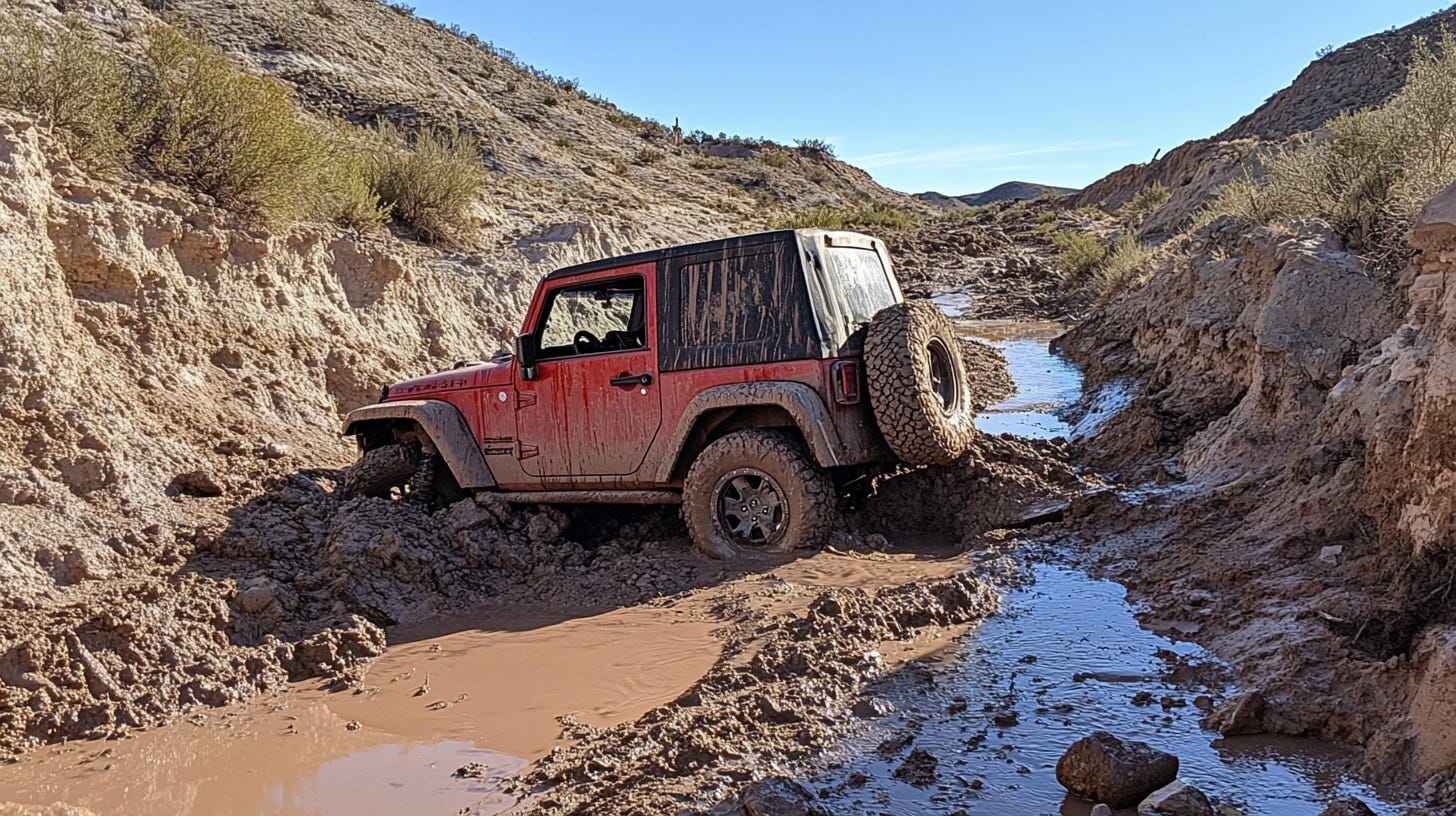Vehicle Recovery 101: What to Do When You Get Stuck

Getting stuck is a part of the adventure when you’re exploring off-road trails. Whether it’s deep mud, loose sand, or rocky terrain, every off-roader eventually finds themselves in a tricky spot. The key is to stay calm and know how to recover safely and efficiently. Here’s a step-by-step guide on what to do when you get stuck and how to get yourself back on the trail.
1. Assess the Situation
Before you start trying to recover your vehicle, take a moment to assess the situation.
- Identify the Obstacle: Are you stuck in mud, sand, or snow? Or is your vehicle caught on a rock or other object? Knowing what’s causing you to be stuck helps determine the best recovery method.
- Check Surroundings: Make sure the area around your vehicle is safe. Look out for uneven ground, rocks, or drop-offs that could pose a danger during recovery.
- Avoid Spinning the Tires: Spinning your tires can make things worse by digging your vehicle deeper. Stop and think about the next steps instead.
2. Reduce Tire Pressure
If you’re stuck in sand, mud, or snow, one of the easiest and quickest ways to gain more traction is to reduce your tire pressure.
- Lower Tire Pressure: Deflate your tires to increase the contact patch with the ground. Lowering pressure to around 15-20 PSI can provide more grip, allowing you to get unstuck more easily.
- Reinflate After Recovery: Don’t forget to reinflate your tires to the appropriate pressure once you’re back on solid ground. A portable air compressor is an essential tool for this.
3. Use Traction Boards
Traction boards are one of the most effective tools for recovering a stuck vehicle, especially in loose terrain like sand or mud.
- Place Traction Boards: Dig out any excess material from around the tires, then place the traction boards in front of (or behind) the tires to provide a solid surface to drive on.
- Slow and Steady: Gently accelerate to move onto the traction boards. Avoid aggressive throttle inputs, as this can cause the boards to slip out.
4. Try the Rocking Method
The rocking method can be helpful when you’re only slightly stuck.
- Shift Between Drive and Reverse: Shift between drive and reverse to gently rock the vehicle back and forth. This helps create momentum and can eventually free the vehicle from the rut.
- Use Controlled Throttle: Be gentle with the throttle—too much power can dig you in deeper.
5. Winching
If you have a winch installed on your vehicle, it’s one of the most reliable ways to recover from a difficult situation.
- Find an Anchor Point: Look for a sturdy anchor point, like a tree or large rock. Use a tree saver strap to protect the tree and provide a secure connection.
- Use a Snatch Block: If you need extra pulling power, use a snatch block to double the winch line and reduce the strain on your winch.
- Winch Slowly and Safely: Always winch slowly and keep tension on the line to avoid sudden jerks. Ensure bystanders are at a safe distance during winching.
6. Recovery Straps and Tow Straps
If you’re traveling with other vehicles, recovery straps can be a lifesaver.
- Attach to Recovery Points: Use designated recovery points on both vehicles—never attach a recovery strap to a bumper, hitch ball, or any non-reinforced part of the vehicle.
- Gentle Pull: The assisting vehicle should gently pull to help free the stuck vehicle. Communication between drivers is key to ensure a smooth recovery.
7. Digging Out
Sometimes, the simplest solution is to dig out around your tires.
- Use a Shovel: Clear away any mud, sand, or snow from around the tires to reduce resistance. Creating a small ramp in the direction you want to drive can also help.
- Use What's Available: If you don’t have a shovel, you can use other tools or even your hands to clear material away from the tires.
8. Using a Hi-Lift Jack
A hi-lift jack can be an incredibly versatile tool for vehicle recovery.
- Lift and Fill: Use the hi-lift jack to lift your vehicle, then fill the space under the tires with rocks, logs, or other material to provide a more solid surface to drive on.
- Safety First: Hi-lift jacks can be dangerous if not used properly. Make sure the ground is stable and that the jack is on a solid surface before lifting.
Safety Tips for Vehicle Recovery
- Use Proper Recovery Points: Always use manufacturer-approved recovery points when attaching winch lines or straps.
- Stay Clear of Cables: When winching, stay clear of the winch cable and keep bystanders at a safe distance. A snapped cable can cause serious injury.
- Work as a Team: If you’re traveling with others, work together during recovery. Having a spotter can help ensure you’re making safe decisions.
- Practice Before You Need It: Vehicle recovery can be challenging, especially if you’re new to off-roading. Practice using your recovery gear in a controlled environment so you’re ready when it matters.

Final Thoughts
Getting stuck is just part of the adventure when you’re off-roading. With the right tools and techniques, you can recover safely and get back on the trail in no time. Whether it’s reducing tire pressure, using traction boards, winching, or getting a little help from your friends, staying calm and methodical is the key to a successful recovery. Equip yourself properly, practice your skills, and embrace the challenges—because sometimes, the best stories start when you get stuck!
Happy trails and safe recoveries!





Member discussion